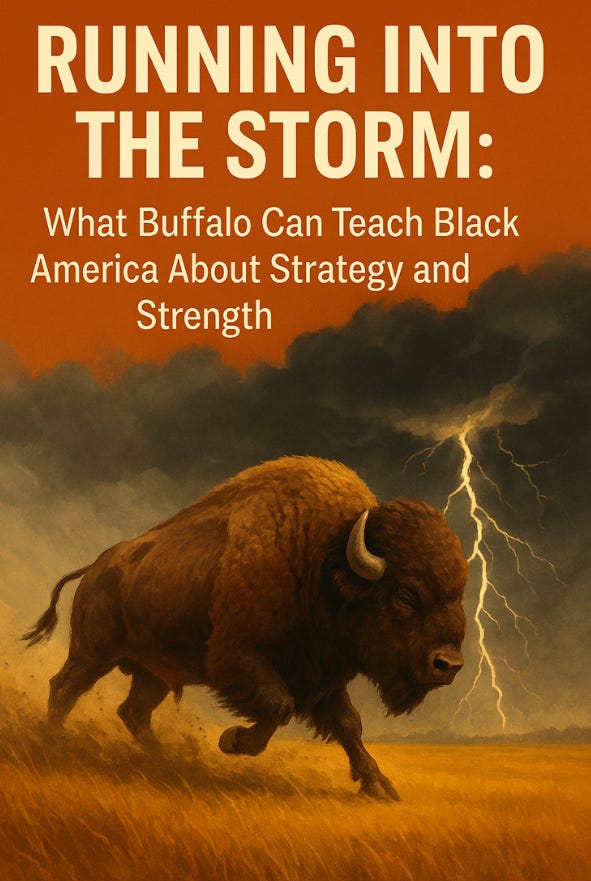Running Into the Storm: What Buffalo Can Teach Black America About Strategy and Strength
When a storm approaches on the open plains, most animals—whether deer, antelope, or horses—instinctively turn and run in the opposite direction. Their natural response is to flee from the danger. But buffalo do something radically different: they turn toward the storm and charge straight into it.
At first glance, this might seem reckless or foolish. But it’s not. Buffalo instinctively understand something profound: by running into the storm, they actually minimize their exposure to it. The faster they face it and move through it, the sooner it’s over. Meanwhile, animals that run away from the storm end up prolonging their suffering by staying in it longer, often being overtaken and worn down.
This simple, natural lesson holds powerful meaning for Black people in America.
Storms Are Natural—and Necessary
Life brings storms. Personal storms, societal storms, political storms. They are not always signs of failure; often, they are catalysts for growth, pruning, and clarity. Rain gives life. Winds can shift stagnant air. Thunder wakes people up.
The Black experience in America has been marked by constant storms—systemic racism, economic exclusion, political disenfranchisement. And too often, the instinct has been to flee, to avoid, or to weather them in silence. We wait for someone else to fix it. We isolate. We pray for clearer skies without preparing for the downpour.
But what if we took a page from the buffalo?
Face the Storm, Change the Outcome
Facing the storm means confronting uncomfortable truths. It means addressing financial literacy gaps head-on instead of avoiding budgeting conversations. It means taking accountability within our own leadership circles instead of waiting for outside systems to crumble. It means organizing our communities politically, economically, and mentally—not just reacting, but preparing and advancing.
Buffalo don’t just endure the storm—they actively reduce the harm it causes by their direction and speed. In the same way, Black communities can reduce the impact of adversity by embracing strategic, culturally specific solutions that are proactive rather than reactive.
Adjusting Strategy, Not Abandoning Hope
Running into the storm doesn’t mean pretending the storm is enjoyable. It means adjusting how we move through it. Here are a few shifts that mirror the buffalo's approach:
Economic storms: Don’t avoid hard conversations about cooperative economics, land ownership, or entrepreneurship. Face them with data, strategy, and collaboration.
Political storms: Stop reacting only in presidential election years. Run into the storm of local politics, judicial elections, and community board seats.
Cultural storms: Instead of being on the defensive about cultural identity, affirm it, build institutions around it, and run into the controversy with unapologetic pride and clarity.
The Pain of Delay vs. the Power of Resolve
Animals that flee storms stay in them longer. Many in our communities are experiencing extended suffering—economic instability, broken trust in institutions, political disillusionment—because we've been avoiding hard but necessary changes. Running into the storm may be hard, but it's shorter. And it's braver. And it's smarter.
The buffalo aren’t braver because they like storms. They’re braver because they’ve figured out that sometimes, the fastest way to peace is through the eye of the problem.
It’s time to face our storms.
---
Let’s stop prolonging our pain. Let’s run into the storm—and come out stronger, together.


